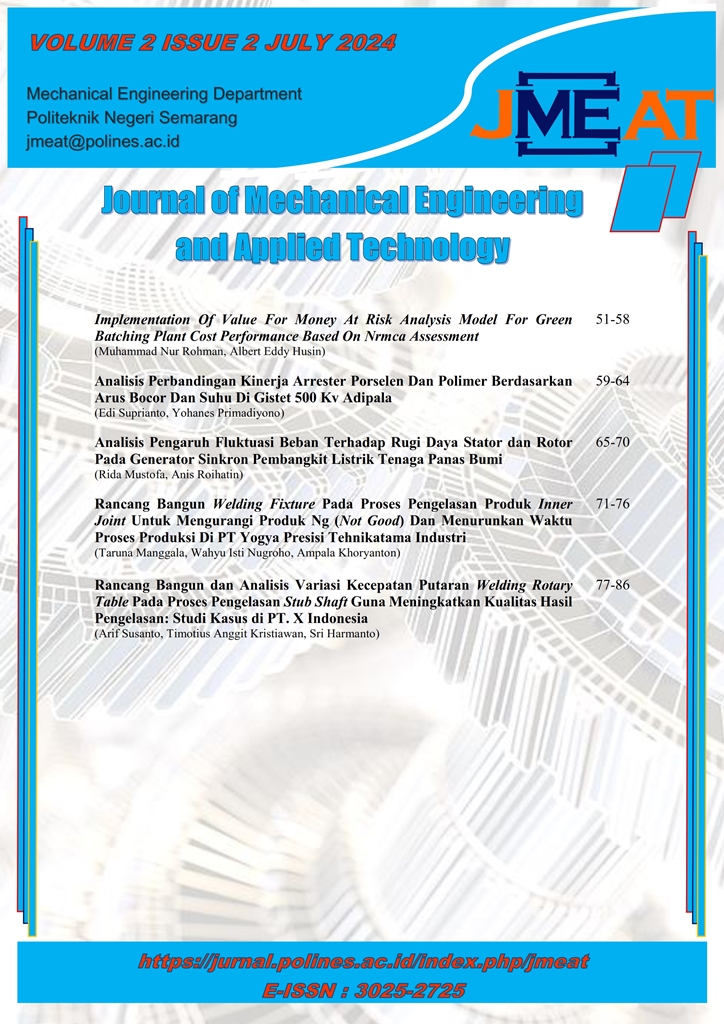Rancang Bangun dan Analisis Variasi Kecepatan Putaran Welding Rotary Table Pada Proses Pengelasan Stub Shaft Guna Meningkatkan Kualitas Hasil Pengelasan: Studi Kasus di PT. X Indonesia
DOI:
https://doi.org/10.32497/jmeat.v2i2.5756Keywords:
Kualitas, Stub Shaft, welding rotary tableAbstract
Proses pengelasan stub shaft di PT X Indonesia masih menggunakan meja manual tidak berputar, sehingga berakibat pada hasil pengelasan stub shaft yang berbentuk oval, dengan begitu mengharuskan operator welder melakukan penambahan pengelasan yaitu 4-6 kali pengelasan memutar supaya hasil pengelasan berbentuk sesuai apa yang sudah ditentukan. Oleh karena itu, penelitian tentang rancang bangun dan analisis variasi kecepatan putaran welding rotary table pada proses pengelasan stub shaft guna meningkatkan kualitas hasil pengelasan sangat penting dilakukan. Tujuan penelitian ini adalah mempercepat proses pengelasan, Melakukan analisa kecepatan normal yang diperlukan untuk melakukan pengelasan stub shaft, dan meningkatkan kualitas hasil pengelasan dengan membuat welding rotary table sebagai alat bantu dalam melakukan stub shaft. menggunakan motor listrik 0,5 Hp 1380 Rpm dan kontrol kecepatan menggunakan inverter ATV310. Metode yang digunakan untuk merancang bangun welding rotary table yaitu Identification of need, Definition of problem, Synthesis, Analysis and Optimization, Evaluation, dan Preparation. Pengujian pengelasan stub shaft menggunakan welding rotary table dilakukan pada shaft Ø100 dan Ø125. Hasil menunjukkan pengelasan pada layer 1 paling baik jika digunakan pada frequensi 7,6-7,1 Hz atau 2,28-2,3 rpm. Pada layer 2 paling baik jika digunakan frequensi 7-5,3 Hz atau 2,1-1,59 rpm. Pada layer 3 paling baik jika digunakan frequensi 4,1-3,4 Hz atau 1,23-1,02 rpm. Pada layer 4 paling baik jika digunakan frequensi 3,1-2,7 Hz atau 0,93-0,81 rpm. Pada layer 5 paling baik jika digunakan frequensi 2,4-2,1 Hz atau 0,72-0,63 rpm. Pada layer 6 paling baik digunakan frequensi 2,2-2 Hz atau 0,66-0,6 rpm. Rata-rata waktu yang diperlukan untuk pengelasan stub shaft menggunakan alat welding rotary table yaitu berkisar 10-11 menit.References
Aditama, D. P. (2022). Pembuatan Meja Putar Sebagai Pemosisi Gerak Berputar Dengan Mengendalikan Motor Ac3 Fase Menggunakan Inverter.
Cahyono, C. D., Qomaruddin, Q., Setiawan, H., & Hudaya, A. Z. (2019). Rancang Bangun Sistem Kontrol Kecepatan dan Ketepatan Penghentian Proses Pengelasan pada Proses Pengelasan Pipa. JURNAL CRANKSHAFT, 2(2), 51-64.
Carli, C., Saputra, E., Daryadi, D., & Sunarto, S. (2022). Aplikasi Jig pada proses pembuatan Hook untuk Meningkatkan Efisiensi Waktu Pengelasan Menggunakan Rotary Welding: Studi Kasus di Industri Karoseri. Jurnal Rekayasa Mesin, 17(2), 325-334.
Deng, H., Cheng, Y., Feng, Y., & Xiang, J. (2021). Industrial laser welding defect detection and image defect recognition based on deep learning model developed. Symmetry, 13(9), 1731.
Dewi, C., Yanto, D. T. P., Candra, O., & Fahlefi, M. (2023). Trainer Kendali Motor Induksi Menggunakan Variable Frequency Drive: Pengujian Jog Dial dan External Potentio Meter. JTEIN: Jurnal Teknik Elektro Indonesia, 4(1).
Kholiq, I., & Ritonga, A. S. (2019). 241 Perancangan Meja Putar Roll Welding Sebagai Alat Bantu Pengelasan (Studi Kasus: ART Welding PT Meco Inoxprima). e-Prosiding SNasTekS, 1(1), 241-252.
Ma, G., Yuan, H., Yu, L., & He, Y. (2021). Monitoring of weld defects of visual sensing assisted GMAW process with galvanized steel. Materials and Manufacturing Processes, 36(10), 1178-1188.
Nasution, E. S., & Hasibuan, A. (2018). Pengaturan Kecepatan Motor Induksi 3 Phasa Dengan Merubah Frekuensi Menggunakan Inverter ALTIVAR 12P. Sisfo: Jurnal Ilmiah Sistem Informasi, 2(1).
Nurrohman, F., Gusniar, I. N., & Sena, B. (2024). Analisa Cacat Las GMAW Pada Proses Pabrikasi Bak Dump Truck Menurut AWS D1. 1 2015 Dengan Metode Inspeksi Visual di PT. XYZ. Journal Serambi Engineering, 9(1), 7663-7668.
Richard G. Budynas, and J. Keith Nisbett.2011. Shigley”™s Mechanical Engineering Design.Ninth Edition : McGraw- Hill series in mechanical engineering.
Suhartini, Y., & Indriani, A. (2021, February). Finite element method for stress analysis in the frame holder of generator translation and rotation motion on vertical direction mechanism for sea wave power plant. In IOP Conference Series: Materials Science and Engineering (Vol. 1034, No. 1, p. 012008). IOP Publishing.
Suparti, E., Wahyudi, A. T., & Fitrianingsih, A. (2023). Total ergonomics approach to analyze work system and propose improvements for increasing worker productivity. OPSI, 16(2), 174-187.
Thanh, P. H., & Doan, N. T. (2020) Control and communication between PLC S7-1200 and ATV310 drive via modbus protocol.
Ulum, M. S. N., Prasetyo, N. B., Sai'in, A., Su'udy, A. H., Hamid, A., & Purnomo, D. (2023). Variasi Frekuensi pada Electric Rotary Table Berbasis Inverter Guna Menurunkan Cycle Time dan Cacat Produk pada Pengelasan Pipa Kapiler. Jurnal Rekayasa Mesin, 18(3), 471-482.
Wanjari, M. B., & Wankhede, P. (2020). Occupational hazards associated with welding work that influence health status of welders. International Journal of Current Research and Review, 12(23), 51-55.
Yohanes, Y., & Meipen, M. (2022). Effect of rotational speed on hardness value and area of vertical bar-plate rotary friction weld joint. Journal of Ocean, Mechanical and Aerospace-science and engineering-, 66(3), 77-81.
Zapata, A., Boehme, M. E., Awidah, A. M., & Chalstrom, P. R. (2023). Power Thyristor Controller for Speed Control of DC Motor.
Downloads
Published
Issue
Section
License
Authors who publish articles in this journal agree to the following terms:
The author owns the copyright and grants first publication rights to the Journal with work simultaneously licensed under a Creative Commons Attribution License which allows others to share the work with the work acknowledged and first published in this journal
Authors may enter into separate, additional contractual agreements for the non-exclusive distribution of the journal's published version of the work (for example, posting it to an institutional repository or publishing it in a book), with an acknowledgment of the first publication in this journal.
Authors are permitted and encouraged to upload their work online (for example, in an institutional repository or on an author's website) before and during the submission process, as this can lead to productive exchanges, as well as earlier citations and a larger number of citations of the published work. (See the impact of open Access).






